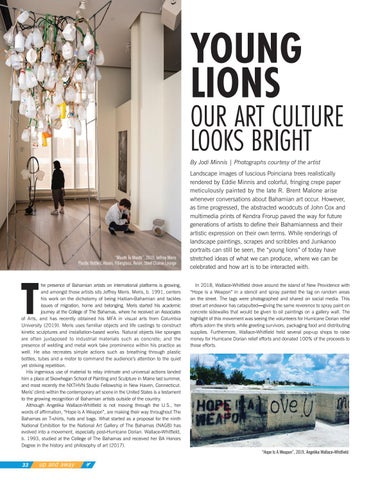YOUNG LIONS
OUR ART CULTURE LOOKS BRIGHT By Jodi Minnis | Photographs courtesy of the artist
“Mouth To Mouth”, 2019, Jeffrey Meris Plastic Bottles, Hoses, Fiberglass, Resin, Steel Chaise Lounge
T
he presence of Bahamian artists on international platforms is growing, and amongst those artists sits Jeffrey Meris. Meris, b. 1991, centers his work on the dichotomy of being Haitian-Bahamian and tackles issues of migration, home and belonging. Meris started his academic journey at the College of The Bahamas, where he received an Associates of Arts, and has recently obtained his MFA in visual arts from Columbia University (2019). Meris uses familiar objects and life castings to construct kinetic sculptures and installation-based works. Natural objects like sponges are often juxtaposed to industrial materials such as concrete; and the presence of welding and metal work take prominence within his practice as well. He also recreates simple actions such as breathing through plastic bottles, tubes and a motor to command the audience’s attention to the quiet yet striking repetition. His ingenious use of material to relay intimate and universal actions landed him a place at Skowhegan School of Painting and Sculpture in Maine last summer, and most recently the NXTHVN Studio Fellowship in New Haven, Connecticut. Meris’ climb within the contemporary art scene in the United States is a testament to the growing recognition of Bahamian artists outside of the country. Although Angelika Wallace-Whitfield is not moving through the U.S., her words of affirmation, “Hope is A Weapon”, are making their way throughout The Bahamas on T-shirts, hats and bags. What started as a proposal for the ninth National Exhibition for the National Art Gallery of The Bahamas (NAGB) has evolved into a movement, especially post-Hurricane Dorian. Wallace-Whitfield, b. 1993, studied at the College of The Bahamas and received her BA Honors Degree in the history and philosophy of art (2017).
Landscape images of luscious Poinciana trees realistically rendered by Eddie Minnis and colorful, fringing crepe paper meticulously painted by the late R. Brent Malone arise whenever conversations about Bahamian art occur. However, as time progressed, the abstracted woodcuts of John Cox and multimedia prints of Kendra Frorup paved the way for future generations of artists to define their Bahamianness and their artistic expression on their own terms. While renderings of landscape paintings, scrapes and scribbles and Junkanoo portraits can still be seen, the “young lions” of today have stretched ideas of what we can produce, where we can be celebrated and how art is to be interacted with. In 2018, Wallace-Whitfield drove around the island of New Providence with “Hope is a Weapon” in a stencil and spray painted the tag on random areas on the street. The tags were photographed and shared on social media. This street art endeavor has catapulted—giving the same reverence to spray paint on concrete sidewalks that would be given to oil paintings on a gallery wall. The highlight of this movement was seeing the volunteers for Hurricane Dorian relief efforts adorn the shirts while greeting survivors, packaging food and distributing supplies. Furthermore, Wallace-Whitfield held several pop-up shops to raise money for Hurricane Dorian relief efforts and donated 100% of the proceeds to those efforts.
“Hope Is A Weapon”, 2019, Angelika Wallace-Whitfield
33
up and away





